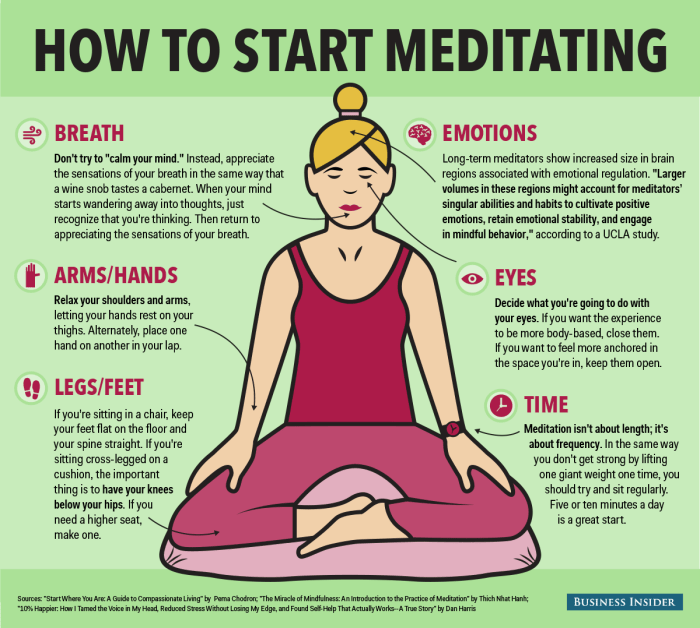Embark on a journey towards inner peace with the comprehensive guide on 4 Steps to Create a Meditation Plan. Delve into the essence of structured meditation and unlock the path to spiritual enlightenment.
Discover the key elements that constitute a well-rounded meditation plan and learn how to integrate them into your daily life seamlessly.
Define Meditation Plan

A meditation plan is a structured Artikel or schedule that individuals create to incorporate meditation practice into their daily routine. It includes specific details such as the time of day, duration, type of meditation, and goals to be achieved.
Having a structured meditation plan is essential for maintaining consistency and discipline in meditation practice. It helps individuals stay organized, focused, and committed to their meditation goals. Additionally, a meditation plan can provide a sense of direction and purpose, making the practice more effective and beneficial.
Benefits of a Meditation Plan
- Enhanced focus and concentration: A meditation plan helps individuals allocate dedicated time for meditation, improving their ability to focus and concentrate.
- Reduced stress and anxiety: Following a meditation plan can help individuals manage stress and anxiety more effectively, leading to a greater sense of calm and relaxation.
- Improved emotional well-being: Regular meditation practice through a structured plan can enhance emotional stability, resilience, and overall well-being.
Elements of a Meditation Plan
- Set specific goals: Define what you aim to achieve through meditation, whether it’s stress relief, improved focus, or emotional balance.
- Choose a suitable time: Determine the best time of day for your meditation practice, whether it’s in the morning, afternoon, or evening.
- Select a meditation technique: Decide on the type of meditation practice that resonates with you, such as mindfulness meditation, guided visualization, or loving-kindness meditation.
- Establish a duration: Set a specific duration for each meditation session, starting with a realistic timeframe and gradually increasing as you progress.
- Create a conducive environment: Find a quiet and comfortable space for meditation, free from distractions and interruptions.
Setting Goals: 4 Steps To Create A Meditation Plan

Setting clear goals in a meditation plan is crucial for guiding your practice and measuring progress. By defining specific objectives, you can stay focused, motivated, and track your development over time.
Types of Goals, 4 Steps to Create a Meditation Plan
- Duration: Setting a goal to increase the length of your meditation sessions gradually.
- Frequency: Establishing how many times per week you aim to meditate.
- Focus: Concentrating on improving your ability to stay present and calm during meditation.
- Emotional Well-being: Targeting goals related to reducing stress, anxiety, or enhancing overall mental health.
Achievable Goals
Setting achievable goals is essential to prevent frustration and maintain consistency in your meditation practice. Start with small, realistic objectives that can be accomplished within a reasonable timeframe. As you progress, you can gradually increase the difficulty of your goals to continue challenging yourself and experiencing growth.
Creating a Routine

Establishing a consistent meditation routine is crucial to reap the full benefits of this practice. It requires discipline and dedication to make meditation a regular part of your daily life. Here are some tips on how to create a sustainable meditation routine and integrate it into your daily schedule:
Tips for Incorporating Meditation into Daily Schedules
- Choose a specific time of day: Select a time that works best for you, whether it’s early in the morning, during a lunch break, or in the evening before bed. Consistency is key.
- Create a dedicated space: Designate a quiet and peaceful area in your home where you can meditate without distractions. This environment should promote relaxation and focus.
- Start with short sessions: Begin with shorter meditation sessions, such as 5-10 minutes, and gradually increase the duration as you become more comfortable with the practice.
- Set reminders: Use alarms or notifications on your phone to remind you to meditate at the designated time each day. This helps establish a habit and ensures you don’t forget.
- Be flexible: While consistency is important, it’s also essential to be flexible and adjust your meditation routine as needed to accommodate changes in your schedule.
Significance of Creating a Conducive Environment
Creating a conducive environment for meditation practice can significantly enhance your experience and make it easier to focus. A peaceful and clutter-free space can help you relax, reduce stress, and achieve a deeper state of meditation. Eliminate distractions, such as noise or bright lights, and consider incorporating elements like soft lighting, calming scents, or soothing music to create a tranquil atmosphere for your practice.
Tracking Progress
Tracking progress in a meditation plan is crucial for ensuring that you are staying on course and reaping the benefits of your practice. By monitoring your progress, you can identify areas of improvement, celebrate milestones, and make necessary adjustments to your routine.
Methods for Monitoring and Evaluating
There are several methods you can use to track and evaluate the effectiveness of your meditation plan:
- Keep a meditation journal: Write down your thoughts, feelings, and experiences before and after each session to track your progress over time.
- Use meditation apps: Many apps offer features that allow you to log your meditation sessions, set goals, and track your progress.
- Utilize wearable technology: Devices like fitness trackers or smartwatches can help monitor your heart rate and stress levels during meditation sessions.
- Seek feedback: Consider working with a meditation teacher or mentor who can provide guidance and feedback on your practice.
Benefits of Tracking Progress
Tracking progress can help in making adjustments and improvements to your meditation plan in the following ways:
- Identifying patterns: By reviewing your progress, you can identify patterns in your practice and make changes accordingly.
- Setting new goals: Tracking your progress allows you to set new goals and challenges as you advance in your meditation journey.
- Staying motivated: Seeing improvements over time can boost your motivation and commitment to your meditation practice.
Wrap-Up

In conclusion, by following the 4 Steps to Create a Meditation Plan, you can cultivate a harmonious balance between mind, body, and soul. Embrace the transformative power of meditation and witness the profound impact it can have on your overall well-being.